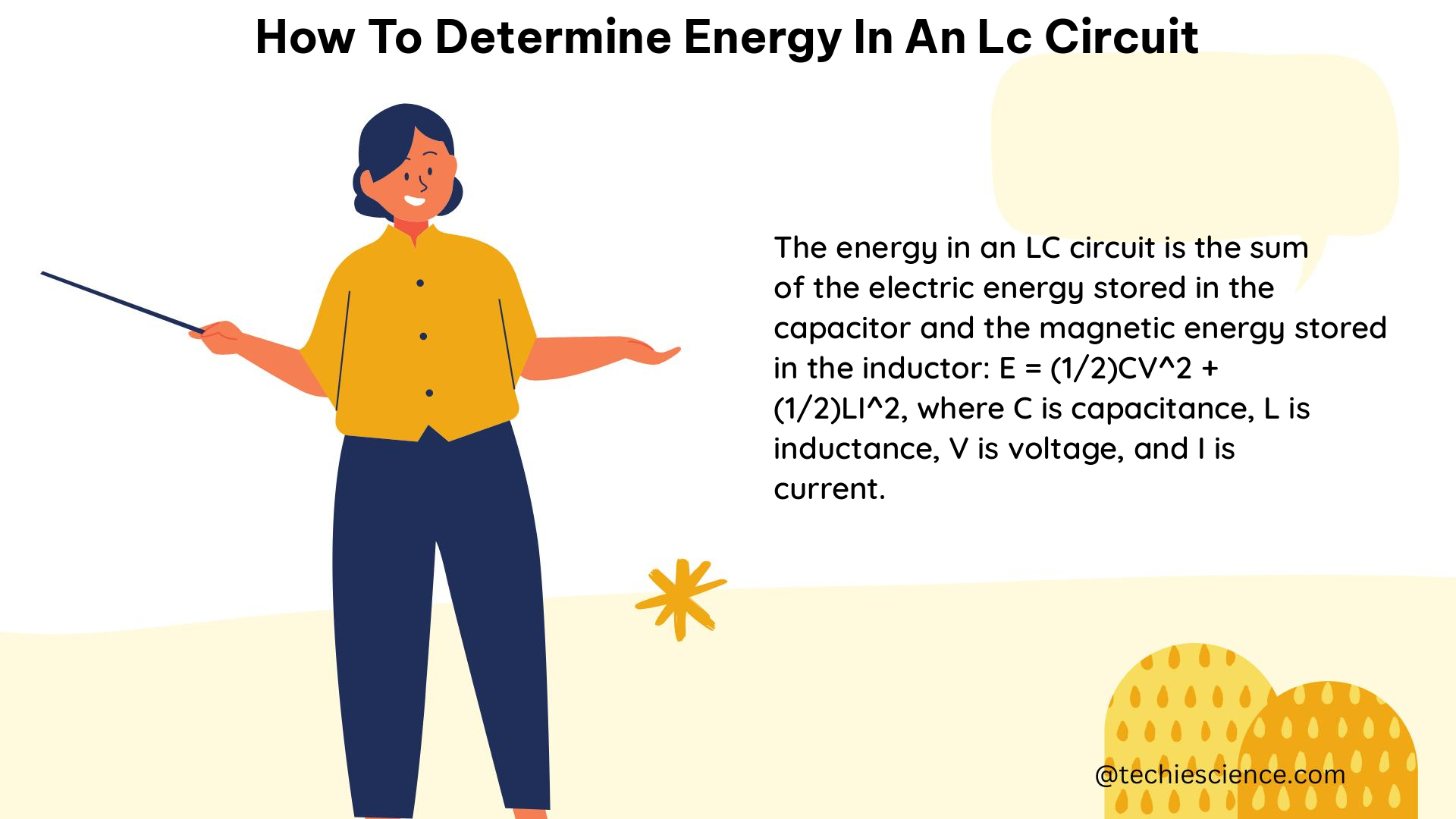In an LC (Inductor-Capacitor) circuit, the energy oscillates between the electric field in the capacitor and the magnetic field in the inductor. Determining the energy in an LC circuit is crucial for understanding the behavior and performance of these circuits, which are widely used in various electronic applications. This comprehensive guide will walk you through the step-by-step process of calculating the energy in an LC circuit.
Step 1: Calculate the Angular Frequency
The angular frequency (ω) of the oscillations in the LC circuit is given by the formula:
ω = √(1 / (LC))
where L is the self-inductance of the inductor and C is the capacitance of the capacitor.
The angular frequency represents the rate of change of the circuit’s oscillations and is a fundamental parameter in determining the energy.
Step 2: Calculate the Charge and Current

The charge on the capacitor (q(t)) and the current in the circuit (i(t)) can be calculated using the following equations:
q(t) = q₀ × cos(ωt + φ)
i(t) = -ω × q₀ × sin(ωt + φ)
where q₀ is the maximum charge on the capacitor and φ is the phase angle.
These equations describe the time-dependent behavior of the charge and current in the LC circuit, which are essential for determining the energy.
Step 3: Calculate the Electric Potential Energy
The electric potential energy stored in the capacitor is given by:
U_E = (1/2) × (q²/C)
This equation represents the energy stored in the electric field of the capacitor.
Step 4: Calculate the Magnetic Potential Energy
The magnetic potential energy stored in the inductor is given by:
U_M = (1/2) × L × i²
This equation represents the energy stored in the magnetic field of the inductor.
Step 5: Calculate the Total Energy
The total energy in the LC circuit is the sum of the electric and magnetic potential energies:
U = U_E + U_M = (1/2) × (q²/C) + (1/2) × L × i²
This equation provides the total energy in the LC circuit, which is the sum of the energy stored in the electric and magnetic fields.
Example Calculation
Let’s consider an LC circuit with the following parameters:
– Inductance, L = 2.0 × 10⁻² H
– Capacitance, C = 8.0 × 10⁻⁶ F
– Initial charge on the capacitor, q₀ = 1.2 × 10⁻⁵ C
-
Calculate the angular frequency:
ω = √(1 / (LC)) = √(1 / (2.0 × 10⁻² × 8.0 × 10⁻⁶)) = 2.5 × 10³ rad/s -
Calculate the maximum current:
i_max = ω × q₀ = (2.5 × 10³) × (1.2 × 10⁻⁵) = 3.0 × 10⁻² A -
Calculate the electric potential energy:
U_E = (1/2) × (q₀²/C) = (1/2) × ((1.2 × 10⁻⁵)²/(8.0 × 10⁻⁶)) = 9.0 × 10⁻⁵ J -
Calculate the magnetic potential energy:
U_M = (1/2) × L × i_max² = (1/2) × (2.0 × 10⁻²) × (3.0 × 10⁻²)² = 9.0 × 10⁻⁵ J -
Calculate the total energy:
U = U_E + U_M = 9.0 × 10⁻⁵ J + 9.0 × 10⁻⁵ J = 1.8 × 10⁻⁴ J
In this example, the total energy in the LC circuit is 1.8 × 10⁻⁴ J, which is the sum of the electric potential energy stored in the capacitor and the magnetic potential energy stored in the inductor.
Additional Considerations
- The energy in an LC circuit oscillates between the electric and magnetic fields, with the total energy remaining constant (assuming no losses).
- The maximum energy stored in the capacitor occurs when the current is zero, and the maximum energy stored in the inductor occurs when the charge on the capacitor is zero.
- The energy stored in the capacitor and inductor is directly proportional to the square of the charge and current, respectively.
- The angular frequency of the oscillations in the LC circuit is determined by the values of the inductance and capacitance, and it represents the rate of change of the circuit’s oscillations.
- Understanding the energy in an LC circuit is crucial for designing and analyzing various electronic circuits, such as oscillators, filters, and power supplies.
References
- Pressbooks.online.ucf.edu. (n.d.). Oscillations in an LC Circuit. [online] Available at: https://pressbooks.online.ucf.edu/osuniversityphysics2/chapter/oscillations-in-an-lc-circuit/ [Accessed 25 Apr. 2023].
- Phys.libretexts.org. (n.d.). 14.06: Oscillations in an LC Circuit. [online] Available at: https://phys.libretexts.org/Bookshelves/University_Physics/University_Physics_%28OpenStax%29/Book%3A_University_Physics_II_-Thermodynamics_Electricity_and_Magnetism%28OpenStax%29/14%3A_Inductance/14.06%3A_Oscillations_in_an_LC_Circuit [Accessed 25 Apr. 2023].
- YouTube. (n.d.). Oscillations in an LC Circuit. [online] Available at: https://www.youtube.com/watch?v=G4VRlrdsBW4 [Accessed 25 Apr. 2023].

The lambdageeks.com Core SME Team is a group of experienced subject matter experts from diverse scientific and technical fields including Physics, Chemistry, Technology,Electronics & Electrical Engineering, Automotive, Mechanical Engineering. Our team collaborates to create high-quality, well-researched articles on a wide range of science and technology topics for the lambdageeks.com website.
All Our Senior SME are having more than 7 Years of experience in the respective fields . They are either Working Industry Professionals or assocaited With different Universities. Refer Our Authors Page to get to know About our Core SMEs.